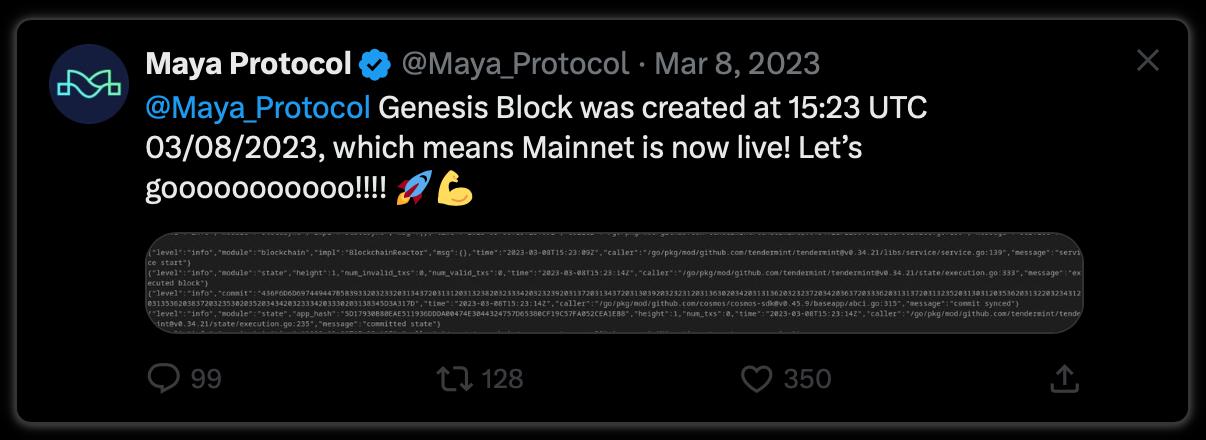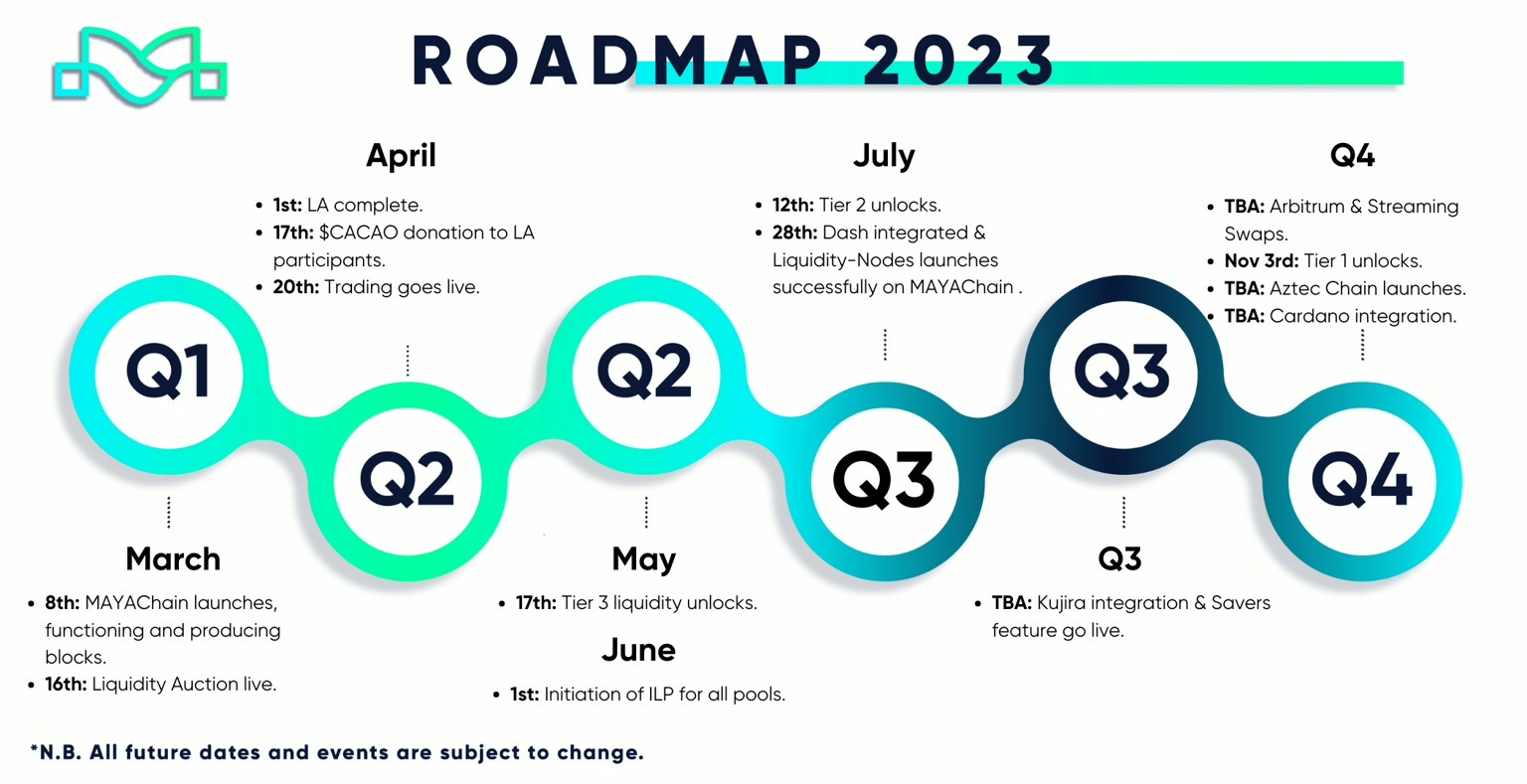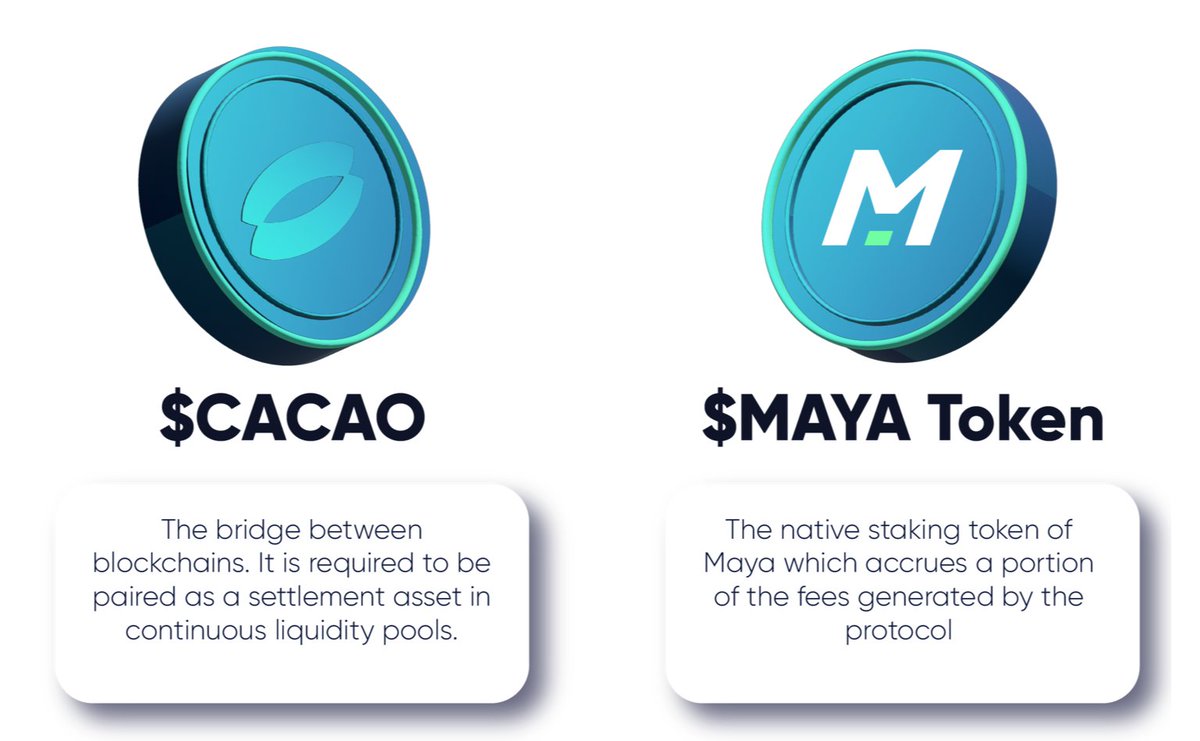%205.42.38%E2%80%AFp.m..png)
From a fair-launchto a thriving cross-chain network — this article traces Maya Protocol’s journey since day one. Discover how its unique economic design, governance model, and ecosystem growth have shaped one of the most resilient DeFi infrastructures today.
DeFi launches often collapse under speculation and short-term greed. Maya Protocol, launched in March 2023, set out to change that—building on THORChain while introducing alternative economic designs that could support long-term liquidity and network resilience. From its first Liquidity Auction, Maya has evolved its progenitor’s familiar mechanisms with structural refinements aimed at durability and fairness.

Image: OG MAYAChain roadmap

Maya began with, and has to this day maintained a dual-token structure. $CACAO serves as the settlement and gas token for all network activity, while its dev token, $MAYA, functions as a revenue-sharing asset, and is designed to distribute a portion of protocol income back to committed supporters. This arrangement established from the outset Maya’s equitable balance between utility and governance.
Liquidity at launch was introduced through a Fair Launch Liquidity Auction, a system of token acquisition where participants committed assets across available pools. The design emphasized depth and stability, offering tiered structures for withdrawals and rewards that encouraged long-term alignment.
Maya’s Day 1 came with an economic security feature called Dynamic Inflation, a governance-based mechanism that, if switched on, would respond automatically to severe shifts in pool liquidity. For instance, if too much $CACAO were to leave the pools, modest inflation would direct rewards back into the system. This dormant, ever-ready feature ensures LP yield without undermining long-term supply integrity.
To further attract and retain liquidity, Maya launched another core economic incentivization feature, Impermanent Loss Protection (ILP), on June 1, 2023, shortly after launch. Its model, diverging from THORChain’s, adopted an asymmetric framework: in cases where external assets strengthened against CACAO, ILP gave liquidity providers faster coverage, while it provided slower coverage in cases where CACAO gained relative strength. This adjustment established for Maya a durable way to protect participants while preserving reserves.
Additionally, Maya’s ILP design is bounded —the ILP obligation is limited to the reserve, which itself continuously receives 10% of total protocol yield.
From its first day in the market, then, these mechanisms—e.g., dual tokens, its fair launch Liquidity Auction, dynamic inflation, asymmetric & bounded ILP—formed Maya’s foundational ground as a sustainable, incentive-aligned cross-chain protocol.

💡 You can learn more though our whitepaper here: https://docs.mayaprotocol.com/white-paper/readme-1-1/usdmaya-token/economic-overview-mt
Following its launch framework, Maya entered a period of refinement where some of its mechanisms were actively tuned and tweaked to improve network health and optimize its sustainability, all while it continued to prioritize user incentivization.
Impermanent Loss Protection (ILP) was extended into a longer horizon for certain conditions. When CACAO appreciated relative to external assets, or when other assets underperformed, protection shifted to a 400-day timeline. This ensured that rapid exits during market stress did not place any outsized burden on protocol reserves, while still rewarding participants who maintained long-term liquidity commitments.
The Liquidity Auction model also evolved. In early 2023, ahead of Maya’s March Liquidity Auction (March 7–30, 2023), the protocol introduced a Tier-based model grounded in lockup duration. Its purpose was to discourage short-term value extraction. Each participant selected one of three tiers tied solely to time-locked commitment and corresponding withdrawal limits:
%205.27.19%E2%80%AFp.m..png)
Such a structure reinforced the network’s objective of building deep and resilient liquidity from inception.
Alongside these changes, $MAYA token distribution was revised. The allocation shifted from 10% to RUNE holders and 10% to early nodes, to a structure of 7% for RUNE holders, 7% for early nodes, 7% for Tier 1 liquidity providers, and 1% for Maya Mask holders. The revision placed greater weight on sustained liquidity provision, linking governance and reward more directly to those maintaining depth in the system.
The auction also included a Ragnarok clause. If the liquidity raised proved insufficient, or if withdrawals threatened network stability, the community retained the ability to return deposits. In such a case, Tier 2 and Tier 3 participants could receive only a portion of their original contribution. This safeguard made risks transparent and emphasized collective oversight from the outset.
Finally, the Dynamic Inflation mechanism was calibrated as an adaptive safeguard. Whenever liquidity levels dropped below a threshold, new CACAO was minted in controlled amounts and allocated directly to pools and system income. This measure preserved LP yield, reinforced network stability, and maintained the attractiveness of providing liquidity even during periods of contraction. So far, this inflation mechanism has not been enabled yet.
Taken together, these adjustments established a more resilient base layer. Incentives were aligned so that deeper and longer commitments translated into greater rewards, while protective mechanisms ensured that the network could continue building stability during its formative phase.
Once these firmer foundations were embedded in the chain, Maya then began expanding its reach through integrations and feature rollouts, both of which helped to broaden participation and utility.
The first phase of expansion focused on core assets and chains. Native Bitcoin and Ethereum pools, along with stablecoin support, established early depth and created the foundation for cross-chain trading without wrappers or custodial bridges. Over time, additional assets (namely Dash, Kujira & Arbitrum) were introduced, extending Maya’s role as a settlement layer for diverse ecosystems.
%205.34.44%E2%80%AFp.m..png)
Protocol innovations also began occurring here. Features, such as Streaming Swaps, which divide large trades into smaller intervals, were implemented into the code. Streaming Swaps helped Maya reduce slippage impact, offer fairer pricing, and open the system to higher-volume users without weakening liquidity positions. This feature became a defining trait of Maya, setting it apart as a DEX designed for efficiency and stability.
As the network matured, strategic integrations continued to accelerate growth. For instance, in September of 2024, Maya integrated with Radix, introducing trust-minimized cross-chain flows to a fast-growing DeFi ecosystem. Then, in June ‘25, support for Zcash introduced a privacy layer to Maya, offering users the ability to route transactions with stronger confidentiality guarantees.
User access also improved through interface development and tooling. Applications such as SwapKit, CacaoSwap, Asgardex, as well as a range of wallets—including Ctrl, Vultisig, and recently, ShapeShift, among others—integrated Maya liquidity, giving participants multiple front-end choices. These partnerships helped to broaden Maya Protocol’s exposure by making its offerings accessible beyond its core community.
During this expansion phase, which extended across assets, chains, and user interfaces, Maya successfully transitioned from a launch-phase protocol into an established, active hub for multi-chain liquidity. Each addition Maya made was done with deliberate consideration, and each helped to increase the network’s depth, breadth, resilience, and ability to serve as infrastructure for scaled decentralized finance.
It should be noted that, since its inception, Maya Protocol has always positioned community participation as an active structural element rather than a surface layer. Distribution models, withdrawal tiers, and protocol safeguards all pointed to the same principle: governance and rewards belong to those who contribute stability and liquidity.
%205.37.05%E2%80%AFp.m..png)
We only have to look as far as the $MAYA token to see this fundamental ethos. With a capped supply and revenue-sharing role, it directed a share of protocol income back to holders who maintained positions over time. Adjustments to its allocation—introducing Tier 1 liquidity providers as a direct beneficiary—helps to anchor governance influence to active contributors rather than just early stakeholders.
The network also embedded collective decision-making mechanisms. Provisions such as the Ragnarok clause gave the community explicit authority to intervene if liquidity conditions threatened the system. These safeguards elevated transparency and signaled that risk management would not be held solely by the core team.
As liquidity expanded and integrations multiplied, the community took on greater significance in shaping Maya’s trajectory. Forums, governance discussions, and protocol votes ensured that adjustments to inflation, distribution, or incentive structures emerged from collective debate. The effect was a model where community oversight and protocol design advanced together, reinforcing Maya’s identity as an open, participatory network.
Maya’s trajectory can be traced through clear, verifiable outputs. The network has moved beyond its auction and launch phase to establish consistent activity across volume, fees, and liquidity depth.
In its first twelve months, Maya facilitated approximately $748 million in swap volume, producing more than $3 million in system fees! The network has recorded a total of over 671,000 individual swaps, a number that reflects steady user engagement over time rather than isolated surges.
Liquidity participation has scaled in parallel. By mid-2025, Maya counted 1,488 liquidity providers across 26 pools, underscoring a diverse base of contributors. Tiered structures designed at launch shaped this distribution, linking longer commitments to greater rewards and ensuring that depth grew alongside participation.
The addition of new chains—Radix and Zcash in particular—extended Maya’s utility and broadened the scope of its pools. Interfaces such as SwapKit and integrated wallets expanded access further, connecting usage metrics to ecosystem growth.
These results collectively trace the growth path of a network that has not only survived its launch cycle–the fairest of fair launches, but grown and matured into a functioning settlement layer. Volume, swaps, fees, and liquidity now define a measurable proof of adoption for Maya Protocol, with each successive integration further establishing and extending its functional growth path.
Maya’s design has always emphasized adaptability. The foundations introduced at launch—dual tokens, tiered liquidity auctions, asymmetric ILP, and dynamic inflation—were structured to evolve as participation and market conditions shifted. That adaptability now positions the network for its next phase of growth.
Remain a primary avenue in the future are more chain integrations. By connecting additional ecosystems, Maya expands both its pool depth and its role as cross-chain infrastructure. Privacy-enabled assets, fast settlement environments, and established DeFi chains all represent directions where Maya can extend its reach.
%205.39.08%E2%80%AFp.m..png)
On the protocol side, continued refinement of incentive mechanisms will remain central. Dynamic inflation and revenue distribution have already demonstrated their flexibility. Future adjustments may fine-tune these systems to reinforce sustainability while keeping liquidity providers aligned with long-term stability.
Community oversight is also expected to grow. Governance discussions around distribution, reserve management, and new integrations will keep shaping the network’s trajectory. The structural role of $MAYA in revenue sharing ensures that these decisions remain tied to participants with enduring commitments.
Maya’s growth since launch reflects a model where economic design, governance, and integrations advance in concert. The path forward builds on this alignment, with the potential to deepen its role as a settlement layer for an increasingly multi-chain environment.
Maya Protocol’s path since launch demonstrates how deliberate design and adaptive governance can translate into measurable growth. The framework introduced on day one—dual tokens, liquidity auctions, asymmetric ILP, and dynamic inflation—set conditions for resilience. Adjustments during the early phase refined these mechanisms, rewarding deeper commitments and ensuring stability in times of volatility.
Expansion through new chains, user interfaces, and tooling extended Maya’s reach. Metrics across swaps, volume, and liquidity provision illustrate steady adoption and confirm that the protocol has moved beyond its launch cycle into sustained operation. Community oversight has anchored this trajectory, with governance structures reinforcing alignment between participants and network health.
Looking ahead, Maya is positioned to build further integrations, refine incentives, and strengthen its role as a cross-chain settlement layer. Its growth story from launch to the present is not only a record of milestones but also a demonstration of how adaptive design can establish durable infrastructure in decentralized finance — an infrastructure that continues to expand as the multi-chain environment matures.